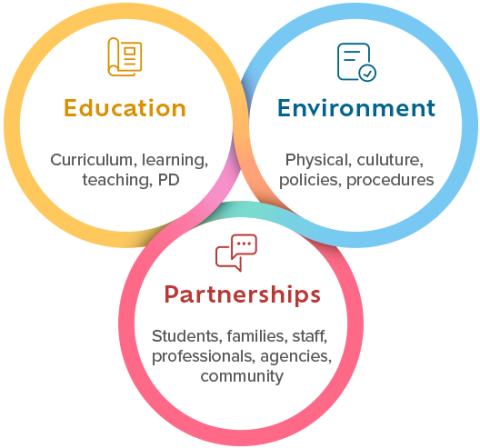
Learning objective
Students examine how success, challenge and failure strengthens their own personal identity.
Take home messages
Curriculum links
WA Curriculum
HPE: Personal identity and change
- Factors that strengthen personal identities, including family, friends and schools.
- Physical, social and emotional changes that occur as individuals grow older.
- Strategies to use when help is needed.
International technical guidance on sexuality education
Key concept 5.5 Finding help and support (5-8 years)
- Friends, family, teachers, religious leaders and community members can and should help each other.
Materials
- Butcher's paper and markers
Before you get started
- Ensure a group agreement is established before beginning this lesson. For classes that have already established ground rules, quickly reviewing them can promote a successful lesson.
- It is possible that a student has been involved in a traumatic experience. Teachers should know and understand the protective interrupting technique and what, why, when and how it is needed and used before facilitating this activity. It is important that teachers are familiar with the Dealing with disclosures guide and have a risk management strategy in place.
Learning activities
Group Agreement
5 minutes
Teaching tip: A group agreement must be established before any Relationships and Sexuality Education (RSE) program begins to ensure a safe learning environment. Read Essential Tool: Establishing a group agreement for tips on how to create one and what to include.
- Revise or create the class group agreement.
Whole Class
15 minutes
This activity addresses students' emotional wellbeing by providing a safe environment for them to explore their strengths and challenges.
- Discuss with students what strengths and challenges people have.
- Ask students to suggest ability and character strengths that they possess, e.g. I am a good listener, I am good at spelling, I am good at sport, I am a good friend, I care about my family, I help my little brother with… etc.
- List the strengths on butcher's paper or on an electronic device.
- Discuss and list challenges in the same way.
- Provide appropriate examples from your own personal experience, modelling the ability to recognise strengths and challenges as well as opportunities to grow, develop and change.
- Ask:
- Does everyone have strengths?
- Does everyone have challenges?
- Do our strengths/challenges change as we get older?
- What can help us identify our strengths? (e.g. asking other people, thinking about what we are good at; thinking about when we feel proud)
- What can help us identify our challenges? (e.g. asking other people, thinking about what we are not so good at; thinking about when we feel sad, disappointed, frustrated)
- How does knowing what our strengths make us feel? (e.g. proud, happy)
- How does knowing our challenges sometimes make us feel? (e.g. sad, disappointed, frustrated)
Independent or Small Group
20 minutes
Students are provided with the opportunity to identify their personal areas of growth and how these can be developed to strengthen their personal identity.
- Display the butcher's paper with the list of strengths from the previous activity. Students individually record at least ten strengths that they can attribute to themselves.
- Alternatively, provide students with coloured dots or pens/textas to place a 'mark' beside the strengths that they consider they have. This is a great visual representation for all as to where the overall strengths of the class are and does not individually identify students.
- Have students now individually identify five personal challenges, e.g. something that they had to be brave about; something that made them sad; something they would like to get better at, i.e. personal challenges. Provide examples of each type of challenge.
- Provide students some reflection time to identify their challenges and how they can address them. Ask:
- Does everyone make mistakes? Even adults?
- Do bad feelings about our challenges last forever?
- Can other people help us with our challenges?
- Who might these people be?
- How can positive thinking help us when we are facing a challenge?
3-2-1 Reflection
15 minutes
- Invite students to share their list of strengths.
- Encourage them to provide examples demonstrating that they have that strength by adding ‘because' and expanding the strength statement. For example, "I am a good friend because I listen to my friend when he is feeling sad".
- Invite students, who feel comfortable, to share challenges they have experienced.
- Encourage them to provide examples and expand the statement to demonstrate that they understand how the challenge can become an area of growth. For example, "I was challenged when my dog died but I talked to Mum and Dad about how I felt and I don't feel as sad now".
- Discuss the following questions:
- What makes something a challenge?
- Can you remember a time when something was too difficult to do, or to cope with, but is now a strength that you have?
- What did you do to turn a challenge into a strength?
Health promoting schools
Background teacher note: Heatlh promoting schools framework

Environment
- Be available to students to come to you when they are struggling
- Know your school's policy around bullying and disclosures of abuse
Partnerships
- Let them you will be discussing resilience in case to continue conversations at home.
- Know local services you can refers students or families who may be going through a tough time and need extra support.



